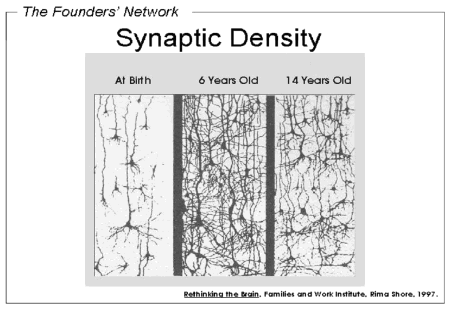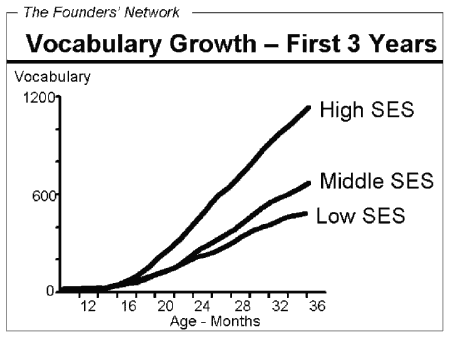Fraser Mustard has used another graphic, this one drawn up by Rima Shore (1997), to show how brain development research data can explain why best teaching practice must include an early start. When synaptic densities are mapped, we see that at birth we are looking at unconnected neurons. The rapidity of brain growth in the early years leads to a mass of dense connections by six years of age. Neural pathways register the totality the child has experienced or noted in the years since birth.
There may be a kind of plateau, a resting point, that follows here (i.e. just when the child is usually brought into a formal schooling system the brain is taking a holiday). And then what is spoken of as a “culling” process takes place, whereby the strongest neural pathways (entrenched observations, memories, rules for living well, practiced skills, and so on) are retained, and unconnected neurons are reabsorbed and effectively disappear.
This allows the brain a greater clarity for adult operational usage, but it also means that new kinds of knowledge are acquired with greater difficulty (while building on kinds of knowledge already acquired is fine because the neural pathways are already established and traversable, and open to the addition of extra details). So the greater the density of neural connections (pathways) in the brain before the culling begins, the more is retained, and the greater the intellectual sophistication, knowledge, judgment and capacity for further learning of the near-adult and adult individual.
Advertisement

The achievement gap
One of the issues that has been taken as a major challenge by the USDE (United States Department of Education) is the “achievement gap” between high achievers and low achievers. This is important also in Australia and the UK, although not for the same reasons: in the US the achievement gap has ethnic links - Asian and white kids do better by a quantum leap than black and Hispanic children.
Efforts at eliminating this gap have been various. But it is now reasonably clear that improving or intensifying educational inputs either in primary or high schools is far less useful than working out how to prevent the gap emerging in the under-five (or under-three!) years.
The issue here is that when children step across the entrance to the school room door their fate is nearly scripted for them at that moment. Either they will do well and enjoy school, or do poorly relative to their peers, feel miserable, and stand condemned to experiencing their school years as some kind of jail sentence.
In the US Head Start is said to have largely failed to address the achievement gap, and this is being blamed on the staffing, which has been by low paid child care workers who have given primacy to good meals and self-esteem boosting without actual “academic” input. Be that as it may, in Australia the primary indicator for our achievement gap is not race but money, or more accurately the SES (socio-economic status) of the parents and neighborhood.
Since everything builds on previous learning, one can understand that when one child arrives at school with a vocabulary double that of a class mate, that child will immediately feel warmly about further learning, while the other will feel on edge, a little intimidated, and defensive - not a good recipe for getting the most out of school.
Advertisement

Now this kind of information has been increasingly available to researchers and academics over the last decade or so. One conclusion that has been drawn by many who have seen a new career path opening up is that early learning centres may be the way to go. Such early learning centres may take children as early as three or more commonly at four years of age, for five half or full days a week.
While four-year-olds may find this easier to handle, this is a long time for a three-year-old to be separated from his or her primary care-giver (mother). We are faced with the dilemma that children are intellectually ready to learn all kinds of things, but are not yet socially mature enough to handle multiple strangers without the presence of a family member (mother).
Discuss in our Forums
See what other readers are saying about this article!
Click here to read & post comments.
1 post so far.